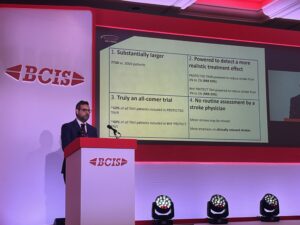
Investigators behind the largest randomised trial to date to assess the use of cerebral embolic protection to guard against stroke during transcatheter aortic valve implantation (TAVI)—BHF PROTECT-TAVI—have reported that the trial is enrolling ahead of schedule and is expected to settle unresolved questions about stroke prevention in TAVI.
The trial is enrolling 7,730 patients undergoing TAVI at centres throughout the UK, randomising 1:1 to TAVI with or without the use of the Sentinel (Boston Scientific) cerebral embolic protection device. Sentinel is designed to be used during TAVI to reduce the risk of stroke by capturing and removing debris dislodged during the procedure before it reaches the brain.
A prior trial, PROTECTED TAVR, which involved around 3,000 patients from centres in North America, Europe and Australia, had shown that the use of the device did not have a significant effect on the incidence of periprocedural stroke, though a difference in rates of disabling stroke, a secondary endpoint in the trial, was believed to confer some benefit to the use of the technology—at least among advocates of the technology. BHF PROTECT-TAVI investigators hope that their trial—which is taking in solely patients treated in the UK—will provide definitive evidence as to whether embolic protection should be considered as an important adjunct to TAVI.
Speaking at the recent British Cardiovascular Intervention Society (BCIS) Advanced Cardiovascular Intervention meeting (BCIS ACI; 31 January–2 February, London, UK) Noman Ali (Leeds Teaching Hospitals NHS Trust, Leeds, UK) offered an update on the status of the trial, as well as setting out the rationale for another large-scale randomised study to look at this issue.
“Despite significant advances in TAVI over the last 15 years or so, periprocedural stroke remains an important issue in contemporary practice, with an incidence of between 2 and 4% across the spectrum patient risk,” Ali explained.
The Sentinel device is the most widely used cerebral embolic protection device, Ali commented, comprising two baskets which protect the right brachiocephalic and left common carotid arteries by filtering debris embolised during the TAVI procedure. During the SENTINEL investigational device exemption (IDE) trial, debris was captured in 99% of cases, Ali noted, but the question remains whether this translates into a meaningful reduction in the incidence of stroke.
In his presentation, Ali addressed whether BHF PROTECT-TAVI remains relevant given the findings of PROTECTED TAVR, noting that there are key differences between the two trials that render this question still an important one to be answered. “Firstly, BHF PROTECT-TAVI is substantially larger, aiming to recruit almost 8,000 patients, compared to the 3,000 in PROTECTED TAVR,” said Ali. “It is also powered to detect a more realistic treatment effect, aiming for a relative risk reduction in the incidence of stroke of 33% compared to the 50% of PROTECTED TAVR.”
Furthermore, unlike the prior study, BHF PROTECT-TAVI is “truly an all-comers trial” Ali noted, enrolling around 40% of all UK TAVI patients, compared to a figure closer to 10% of eligible TAVI patients in PROTECTED TAVR. Another key difference is that there will be no routine assessment by a stroke physician, meaning that, though some minor strokes may be missed, the trial will place more emphasis on clinically relevant strokes, and may “tease out the benefits of cerebral embolic protection devices more effectively”, said Ali.
BHF PROTECT-TAVI will also provide more data to shed light on one of the important findings of PROTECTED TAVR—the difference in rates of disabling stroke. In PROTECTED TAVR, the incidence of stroke within 72 hours after TAVI or before discharge—the trial’s primary endpoint—did not differ significantly between the cerebral embolic protection group and the control group (2.3% vs. 2.9%), whereas disabling stroke—a secondary endpoint—occurred in 0.5% of the patients in the cerebral embolic protection group and in 1.3% of those in the control group, a significant difference. This finding has coloured much of the debate over the merits of cerebral embolic protection since the release of the data in 2022, with proponents of the technology arguing that this underscores the merit of its use during TAVI.
“Whilst PROTECTED TAVR showed a significant reduction in the incidence of disabling stroke, it wasn’t powered for this secondary endpoint. In contrast, BHF PROTECT-TAVI will have adequate power to confirm this effect,” said Ali.
At the time of the presentation, 32 out of the UK’s 33 TAVI centres have been recruited in the study, with enrolment standing around six months ahead of schedule, making a completion date of early 2025 possible if this is maintained.
“The trial is recruiting well,” BHF PROTECT-TAVI lead researcher Rajesh Kharbanda (John Radcliffe Hospital, Oxford, UK) commented following Ali’s presentation. “I get a text every time a patient is recruited, so I know that we are at 5,814 this morning. We are 75% through the recruitment.”
Furthermore, Kharbanda revealed that the investigators are planning to aggregate the findings of both trials in the form of a meta-analysis with the PROTECTED TAVR study team, adding up to a sample size of more than 10,000 patients. “You need those sorts of numbers to show efficacy in these low frequency but serious events,” Kharbanda said.
The Sentinel device is currently the furthest advanced cerebral embolic protection system in the market, though others are under investigation. In the second half of 2023, EnCompass Technologies granted conditional IDE approval by the US Food and Drug Administration (FDA) for its F2 cerebral embolic protection system, whilst the Emboliner (Emboline) system is also being investigated in the USA in a head-to-head trial with Sentinel, enrolling its first patient in May of the same year. Filterlex Medical has also conducted a first-in-human (FIH) study demonstrating the safety, feasibility, and performance of its Captis full-body embolic protection device in TAVI.
During the BCIS ACI session, Kharbanda was asked whether BHF PROTECT-TAVI would reflect cerebral embolic protection as a strategic approach, or if the results would suggest a device-specific outcome with Sentinel.
“The trial has been designed as a test of strategy,” he said. “Other devices are making their way through the regulatory process, but I think given the power and magnitude of this trial, this will tell us whether embolic protection has any chance of being successful or not.”













